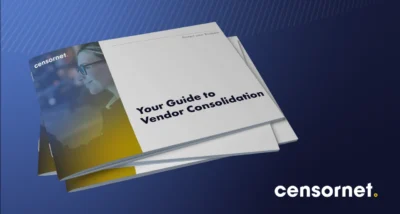Consolidating your cybersecurity vendors comes with a whole host of benefits, from reduced workload to improved threat intelligence. But it’s not a magic solution to every business challenge – particularly when it comes to cost.
In recent Gartner research, only “29% of organisations said they consider reduced spending on licensing to be the primary benefit of vendor consolidation”. It was the lowest ranked benefit. At the same time, 15% felt that “increased spending could be a drawback of consolidation” – a significant number (although this was not the leading drawback). In other words, if you’re looking to save a quick buck, consolidation may not be the shortcut you’re looking for.
However, mid-market firms are facing more financial pressures than ever – which means there’s a need to stay focused on reducing complexity and increasing efficiency across the board – something consolidation does very well. Cost savings may not come directly off the license budget, but when the team is working better, faster, and the organisation is achieving better security with less back-end management and admin workload, then savings come in other ways.
And although consolidation may not always equate to immediate savings, it also doesn’t have to break the bank or come with a price hike. Companies don’t have to rip and replace – just slowly move to consolidation to make the change cost effective.

The monthly bill is important, but it also can’t be the sole deciding factor in whether or not to pursue consolidation. Put simply, the more siloed point products you deploy, the greater the chance you’ll end up with blind spots and gaps that attackers can exploit. Consolidation allows for more tightly joined-up defences, with multiple products operating from the same unified platform.
The risks of a patchy defence

That kind of joined-up protection is more important now than ever. The threat level for the mid-market is increasing, both in volume and the complexity of the attacks. As many as two in three (65%) mid-market organisations suffered an outage in 2021, with half (33%) seeing systems knocked offline for more than a day. This rate of attrition isn’t surprising: in order to stay protected, mid-market businesses need to stop over a billion cyber threats a day.
And the risk is increasing. According to Accenture’s Cost of Cybercrime report, malware is the most expensive type of cybercrime in the UK, and is now costing firms 15% more than in previous years. The evolution of cybercrime means that costs stack up quickly for businesses – whether that’s through upfront ransom, recovery costs, or managing the aftermath of a breach.
The reputational impact of not being fully protected is also huge: this isn’t about consolidating for consolidation’s sake. According to the Journal of CyberSecurity firms experience a 5-9% decrease in reputational intangible capital following a major data breach.
Put together, the bottom line is that licensing costs are far from the only cost to be considered for mid-market businesses. A consolidated defence could end up saving a great deal both financially and reputationally.
Reducing the cost of cyber threats
So what does that look like in practice? What benefits does consolidation bring that will help achieve those savings?
First off, a consolidated approach means teams can move away from the more expensive and time-consuming approach of running separate solutions in silos. Rather than overseeing a portfolio with all the various update schedules, integrations, after-sales services, and management requirements that entails, IT teams can hand the majority of the back-end work to a single vendor. Implementation of new capacities and products comes as standard, and monitoring and reporting can be handled through a single dashboard, rather than a forest of different systems. As a result, staff time is freed up, integrations run more smoothly, and the costs of keeping up with evolving threats comes down.
Consolidation also enables the running of truly digital business, giving users the freedom to access the applications and data they need regardless of device or location, whilst providing visibility for IT and adequate protection. Rather than having to consider new contracts or providers to protect evolving tech requirements and an ever-more mobile workforce, the relevant capacities can be added to the platform as required. Joined up security also ensures that dispersed staff pose less of a risk: threats can be tracked across devices and apps, ensuring that cross-channel attacks are stopped early.
Finally, consolidation helps organisations move to a zero trust posture, the next step in the evolution of cyber security – where every user and every request is granted the least amount of privilege. Under zero trust, authentication is based on rich contextual data – the more the security system knows about a user’s behaviour, the more accurately it can identify them and grant access when appropriate. A consolidated system enables deeper insight, allowing for a user-friendly, high-security zero trust approach.
In the end, the long-term benefits of consolidation heavily outweigh any questions about immediate cost-savings, or the lack thereof. With the financial and reputational costs of cybercrime higher than ever, it’s an opportunity businesses can’t afford to miss.







